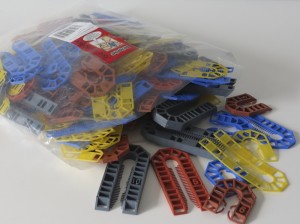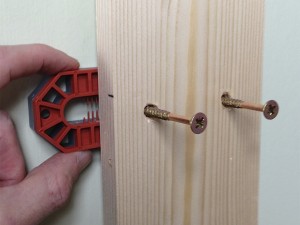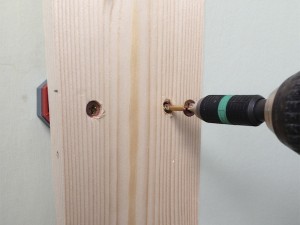Shims
Shims are quite simply little pieces of plastic that you can use for any number of ‘packing out’ jobs in your DIY activities. Why am I giving over an entire blog post to shims you may be wondering, well, call me sad, call me obsessive, but give me a pack of shims, a pile of wood, and a job to do, and I really am the proverbial pig in muck. Why? Because they make jobs easier, quicker, more accurate, and save enormous amounts of time. My primary use for them are as aids for fitting a door lining, but there are any number of predominantly carpentry based jobs where I find shims to be invaluable. I think that plastic shims were initially designed for trade use, but the fact is that they are one of the best DIY aids you can buy.
Shim packs
 Shims come in a range of sizes, typically starting at 1mm going up to 10mm. You can buy packs all in one size, but without doubt I find the assorted packs (see right) the best option so you’re ready for all occasions.
Shims come in a range of sizes, typically starting at 1mm going up to 10mm. You can buy packs all in one size, but without doubt I find the assorted packs (see right) the best option so you’re ready for all occasions.
In a world before plastic shims, carpenters would make little wooden packers or wedges to pack out door linings, frames, windows etc. to ensure that openings are precisely ‘square’. This is fine but, a) you’ve got to cut them to size so immediately you have labour time and accuracy issues and, b) wooden wedges often split, fall out, break, and c) you often find yourself wishing you had something slightly larger or slightly smaller. With plastic shims, you have precise sizes and therefore accuracy, you don’t need to ‘make’ them, and their design makes them less likely to slip out of place.
Packing out a lining
As mentioned earlier, packing out a door lining or frame is my primary shim use. Once you’ve built your lining, whether it be for a door, wardrobe or cupboard, when you offer it up to the rough opening, you simply slot the shims in place to keep the lining ‘square’ and provide perfect secure fixing positions. The example below shows a wardrobe lining being fitted to a wall.
 |
1. You simply pack out at the fixing points as required. The design of the shims allows you to insert the screws through the central area of the shims, so they don’t fall out. |
 |
2. When you secure the lining in place, the shims maintain the ‘square’ shape of your lining and provide rock solid fixing positions. If you don’t quite get it right first time as when you put your level on the lining and it’s been pulled out of ‘square’, you can simply loosen off the screws and add or take out shims as needed – with millimetre accuracy! |
Other uses for shims
1. Fitting windows
This is really the same principle as with a door lining, as when you’re trying to keep the window frame ‘square’ in the rough opening, you need to pack out around the frame to ensure  you don’t distort it when fixing it in place.
2. Levelling and replacing floorboards
A floorboard that is sitting below the level of others can simply be lifted and shims positioned on the joists before re-fixing the board to get it flush with the surrounding boards. Again this avoids messing around with little wooden wedges, and you can be millimetre perfect with ease. Similarly, you often find that when replacing a floorboard in an old house, it’s difficult to buy new boards of precisely the correct depth. Therefore, if you buy floorboards of a depth slightly less than would be perfect, you simply pack them ‘up’ with shims.
3. Stud wallsÂ
When you’re putting up a stud wall, shims are great for packing the frame off uneven walls to ensure that the studs are vertical.
4. Wood and laminate flooring
Shims can be used as spacers around the edge of your laminate or wood floor installation to maintain consistent expansion gaps.
5. Fitting a kitchen
Very handy to have about when you need to shift units or cabinets into millimetre precise positions.
……and of course there are many, many more applications where you’ll find yourself reaching for your trusted bag of shims. There are different designs available, but I find the U-shaped options shown above to be the most useful and effective. For reasons that I certainly can’t work out, you’re not going to find these shims in any of the major DIY outlets (as far as I know), so I always buy this assorted pack from Screwfix, or if you prefer they are also available on Amazon. So finally, if you do any carpentry based DIY around your home, I’d urge you to have a pack to hand – and you’ll soon be wondering how you ever managed without them!
Â
